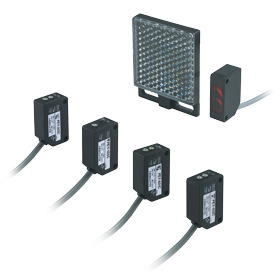Column
FEATURE DETAIL
ColumnColumn
Automation Basics ~ Automate the works with photoelectric sensors
What is automation?
Automation means that the machines works automatically without human intervention.
Automation makes it possible to solve labor shortages and work style reforms, prevent mistakes, improve efficiency by stabilizing quality and speeding up the work. Also, automation makes it possible to work in the environments with high temperature, low temperature, and noise.
Automation makes it possible to solve labor shortages and work style reforms, prevent mistakes, improve efficiency by stabilizing quality and speeding up the work. Also, automation makes it possible to work in the environments with high temperature, low temperature, and noise.
The basis of automation is from the sensor
There are various methods and devices for automation, but what should we start with?
As the basis of automation the best way to start is to use sensors to automate the switches that have been checked and operated by humans so far.
We explain about the sensor this time in below.
As the basis of automation the best way to start is to use sensors to automate the switches that have been checked and operated by humans so far.
We explain about the sensor this time in below.
What is a photoelectric sensor?

Photoelectric sensor is to detect the presence or absence of an object using light.
Also known as a photoelectric switch, the switch turns ON/OFF depending on the detected object.
It is used for various purposes such as the presence or absence of objects, positioning, and finding protrusions.
Also known as a photoelectric switch, the switch turns ON/OFF depending on the detected object.
It is used for various purposes such as the presence or absence of objects, positioning, and finding protrusions.
Features of photoelectric sensor
1. 1. Non-contact
Since the photoelectric sensor detects non-contact, it does not affect the object such as scratches.
2. 2. There are few restrictions on detected objects
Most objects can be detected if they are solids other than transparent bodies.
Transmissive type

There is a light emitter that emits light and a light receiver that receives light, and the object is detected by blocking the light with the objects.
In general, the detection distance is longer than other types, and it is the most stable and reliable method for detecting objects other than transparent objects (opaque objects).
However, it is necessary to install both the emitter and the receiver.
In general, the detection distance is longer than other types, and it is the most stable and reliable method for detecting objects other than transparent objects (opaque objects).
However, it is necessary to install both the emitter and the receiver.
Regressive reflection type (mirror reflection type)

Objects are detected by blocking the light reflected by the retroreflection plate.
The reflector can be installed in a narrow space, wiring is simple (wiring on one side), and detection distance can be longer than diffuse reflection type.
Moreover, since only the light reflected by the reflector is received, the material and shape of the detected object are less likely to affect it.
(The technology called polarization is used not to receive the reflected light from the detected object )
The reflector can be installed in a narrow space, wiring is simple (wiring on one side), and detection distance can be longer than diffuse reflection type.
Moreover, since only the light reflected by the reflector is received, the material and shape of the detected object are less likely to affect it.
(The technology called polarization is used not to receive the reflected light from the detected object )
Diffuse reflection type

Projector and receiver are housed in one case, and an object is detected by the reflection of light from the detected object.
However, detection is not stable depending on the material and shape of the detected object, since the detection is based on the reflection of the detected object. (Black color, specular surface, cylinder might be instable)
Diffuse reflection type

Projector and receiver are housed in one case, and an object is detected by the reflection of light from the detected object.
However, detection is not stable depending on the material and shape of the detected object, since the detection is based on the reflection of the detected object. (Black color, specular surface, cylinder might be instable)
Reflective type

Similar to the diffuse reflective type, the object is detected by the reflection of light from the detected object.(Diffuse reflective type is determined by the amount of reflected light received.)
Distance can be measured by time or calculated from the light receiving angle.
Since the distance is measured it is not affected by the background behind the object, and also it is unlikely to be affected by the material and shape.
Distance can be measured by time or calculated from the light receiving angle.
Since the distance is measured it is not affected by the background behind the object, and also it is unlikely to be affected by the material and shape.
Product's Category
- Scanning Rangefinder
- Photoelectric Switch
- Sensor for Iron & Steel Industry
- Optical Data Transmission Device


